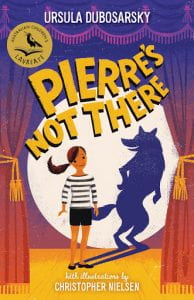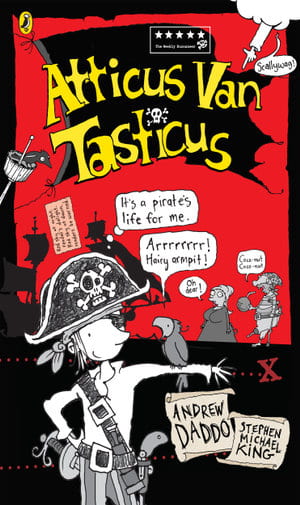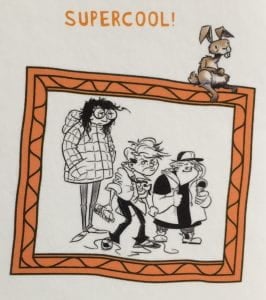It was wonderful, yet again, to be in touch with the passionate people associated with CBCA in the Blue Mountains.
 The meeting was tinged with sadness due to the recent passing of Margaret Hamilton – a tribute from CBCA expressed here. Colleagues and friends shared some emotional and meaningful final moments with Margaret, which will echo her passion and personality when we celebrate at her ‘after party’ sometime soon.
The meeting was tinged with sadness due to the recent passing of Margaret Hamilton – a tribute from CBCA expressed here. Colleagues and friends shared some emotional and meaningful final moments with Margaret, which will echo her passion and personality when we celebrate at her ‘after party’ sometime soon.
The passions of writers, teacher-librarians, librarians and booksellers and partners in this group were obvious, as ideas and experiences were shared – recollections of the year past, and ongoing plans for the future.
Stitching some of these together was an informal chat from James Roy. He spoke about the inspiration for his writing, about his physical writing process (ask his wife how intense that ‘impression’ is) and the search for ‘real’ on which to create ‘fiction’. He also teased us with snippets about a new book soon (about time!). Many were still keen to get our hands on this one – One Thousand Hills – unfortunately, now out of print, but fingers crossed for a revival. (See a past – 2016 – review here)
Once again, the meeting was anchored by a magnificent meal, hosted by Sheryl, and prepared by Monique from the Farm – so lucky to still have Monique connected to BM CBCA events for her amazing food.
In 2023, CBCA are looking for more ways to promote and encourage children’s enthusiasm for the amazing literature we have around us – here in the Blue Mountains, and further afield in Australia; to get our kids reading both enthusiastically and voluntarily.
Can you connect to promote great books to your students? Start here.
# Margaret’s memoir, Falling Forward, is soon to be released, and will be officially launched at her ‘after party’. See details here.
 At a time when minimalism is so widely promoted, have you ever wondered about the value you place on objects in your home? Are there precious items you would find it hard to throw out? what if someone else threw out things you valued?
At a time when minimalism is so widely promoted, have you ever wondered about the value you place on objects in your home? Are there precious items you would find it hard to throw out? what if someone else threw out things you valued? Life has a way of falling apart sometimes. For Mercy, the solution has been spending 2 years as a recluse in her home. When this house burns down, she is thrown out into the world and flounders to accept the help her ex-husband offers, which can only be temporary anyway.
Life has a way of falling apart sometimes. For Mercy, the solution has been spending 2 years as a recluse in her home. When this house burns down, she is thrown out into the world and flounders to accept the help her ex-husband offers, which can only be temporary anyway.

 Tohby also spoke warmly of their past work together at
Tohby also spoke warmly of their past work together at  Finally, Ursula spoke about her inspiration for ‘Pierre’s Not There’ – visiting the Palace of Versailles – almost under protest – at the least, disinterested – then sidetracked by a French puppet theatre nearby. Her puppet theatre visit, subsequent emotions and thoughts about this exploration inspired the events portrayed in ‘Pierre’s Not There’. And her haunting recollections ‘illuminate’ her feelings where this tale began. It’s always interesting to get into the mind of an author and hear where ideas come from…
Finally, Ursula spoke about her inspiration for ‘Pierre’s Not There’ – visiting the Palace of Versailles – almost under protest – at the least, disinterested – then sidetracked by a French puppet theatre nearby. Her puppet theatre visit, subsequent emotions and thoughts about this exploration inspired the events portrayed in ‘Pierre’s Not There’. And her haunting recollections ‘illuminate’ her feelings where this tale began. It’s always interesting to get into the mind of an author and hear where ideas come from… After reading Favel Parrett’s
After reading Favel Parrett’s  ‘Being Jazmine’ is the third book featuring Jazmine Crawford – part of the Invisible series by Cecily Paterson. That said, it was also a good read as a stand-alone title.
‘Being Jazmine’ is the third book featuring Jazmine Crawford – part of the Invisible series by Cecily Paterson. That said, it was also a good read as a stand-alone title. Suspend all normal thinking. Suspend being a normal ten-year-old. Atticus wants to be a pirate!
Suspend all normal thinking. Suspend being a normal ten-year-old. Atticus wants to be a pirate! With so many great YA books about, it’s not often I pick up and review something for younger readers. However, I have just chuckled my way through the first book of ‘Derek Dool Supercool’ series – ‘Bust a Move’.
With so many great YA books about, it’s not often I pick up and review something for younger readers. However, I have just chuckled my way through the first book of ‘Derek Dool Supercool’ series – ‘Bust a Move’.

 As the
As the 